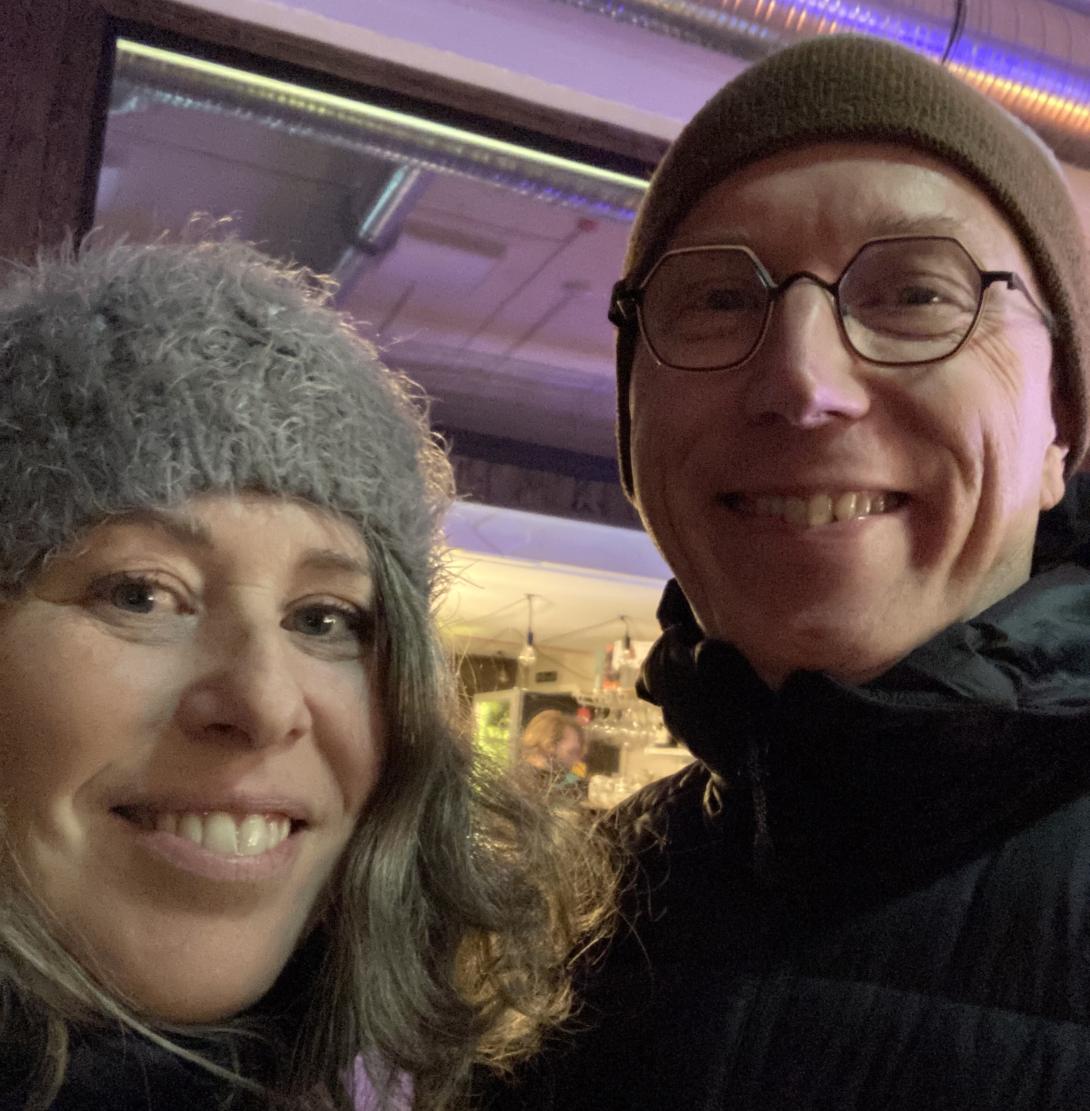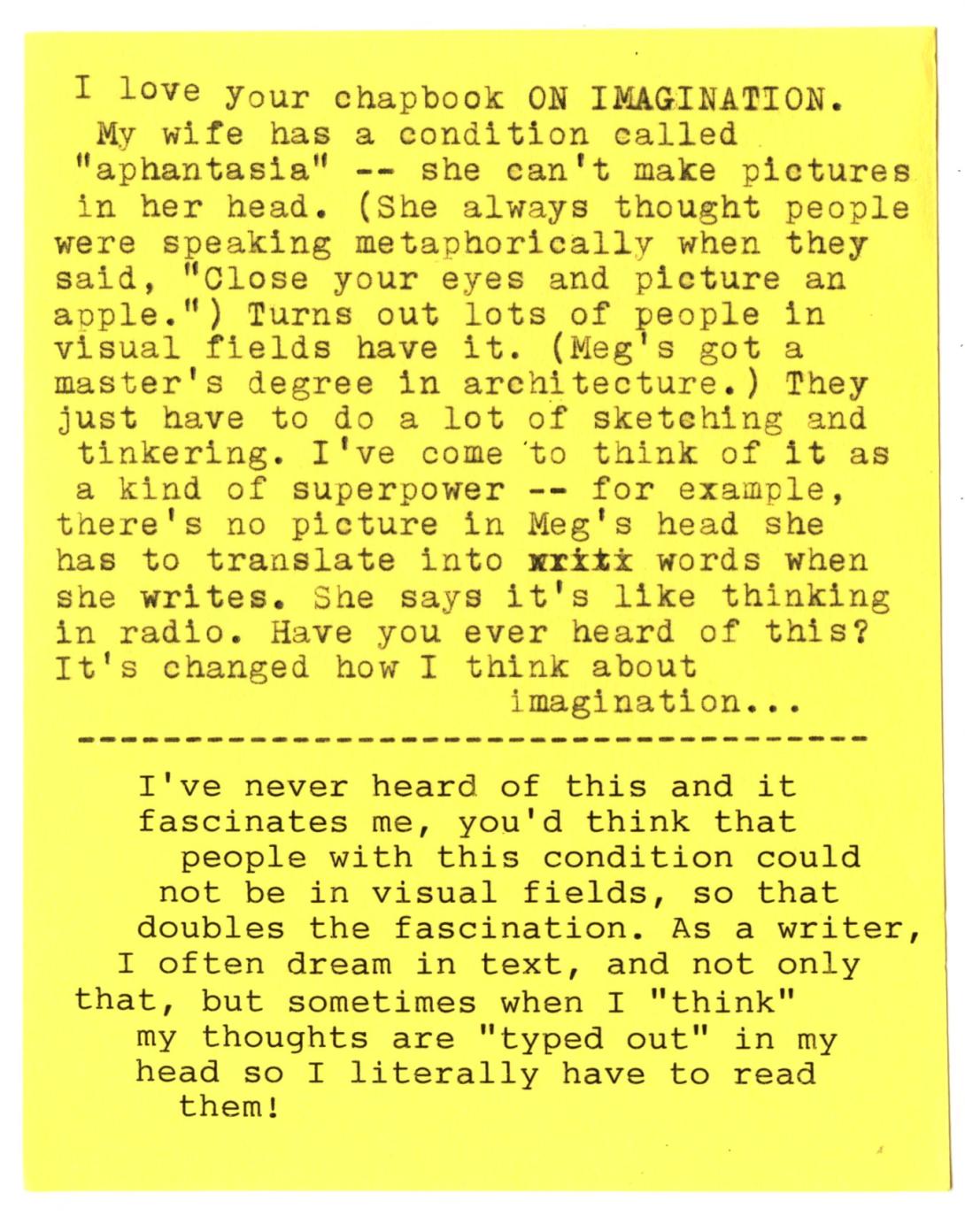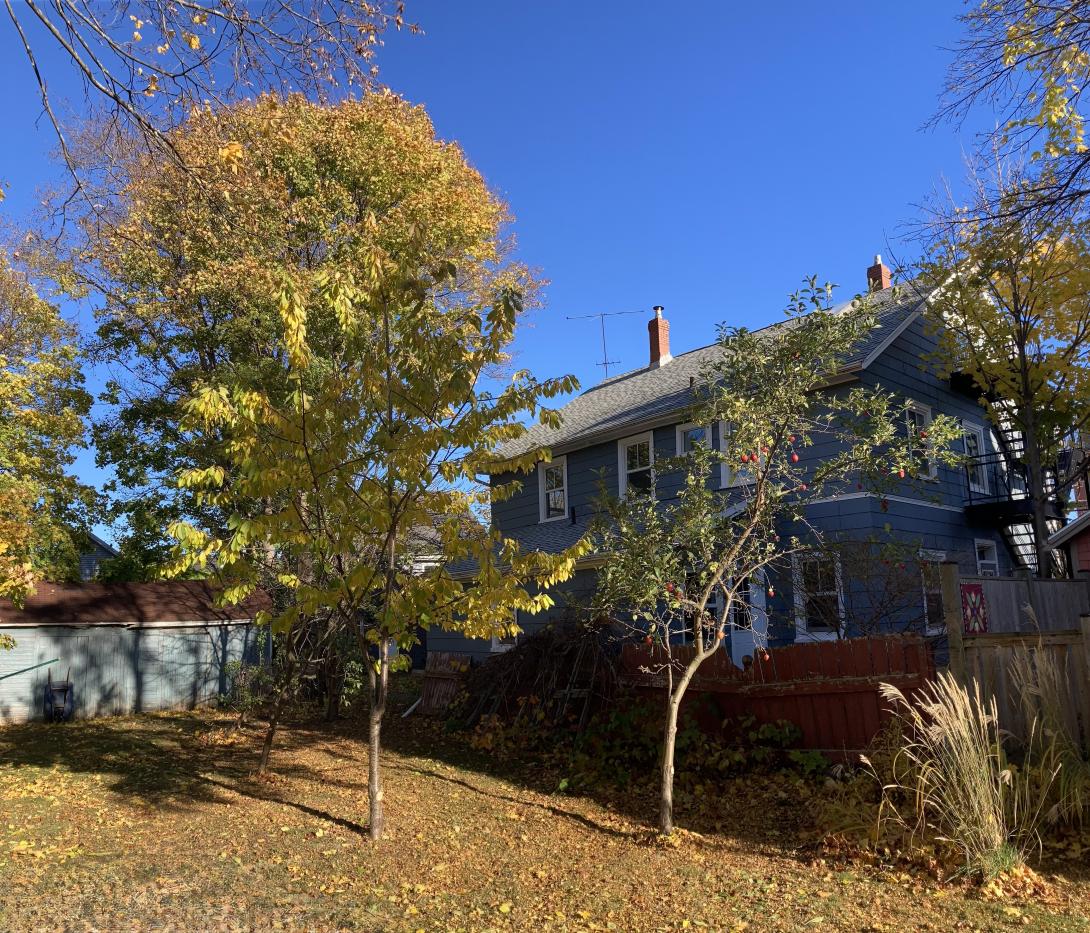I love this paragraph from the CBC story Vet college suggests its MRI could shrink the wait times for P.E.I.’s human patients:
Griffon said the AVC needs to build a reception area for human patients, so that they don’t have to use the same entrance as dogs or horses.
In a recent episode of The Knowledge Project, storyteller Matthew Dicks was asked “What’s the difference between a good story and a bad story?”. Part of his reply:
So a story is about change over time. Usually, it’s sort of a realization.
Like, I used to think one thing, and now I think another thing. That’s most stories. Sometimes they’re transformational, meaning I once was one kind of person, and then some stuff happened, and now I’m actually an authentically different kind of person.
Five years ago today I wrote this to family and friends in a newsletter about my late partner Catherine’s cancer:
Catherine is by no means at the end of her treatment options, but it’s clear, both from empirical evidence and from Dr. Corbett’s demeanour, that she’s entered a new act of this play. Meaning that, if you were planning to nominate her for a Nobel Peace Prize, I’d start assembling your paperwork (they take forever to process things).
But she is not on death’s door.
It turns out that Catherine was at death’s door: 6 days later she decided to suspend treatment for the holidays; 11 days later she was admitted to hospital with a hip socket fracture; 16 days later she came home for Christmas; 24 days later she was back in the hospital, in a morphine-induced delirium; 41 days later, she died.
When Catherine was diagnosed with cancer, in the fall of 2014 I was, in Matthew Dicks words, “one kind of person.” I remained that kind of person for the next six years. I was that kind of person when she died, and for a long time afterward.
Some things about that kind of person:
I was afraid, but unwilling to admit it.
I was desperately lonely, but unwilling to admit it.
I thought I could control chaos by writing about it, that a dose of distracting levity could pierce any bad news.
I thought my job was, at any cost to myself, to prevent calamity, to contain, manage, anticipate.
I saw vulnerability as a weakness, a third rail to be avoided.
I had a long list of things I wouldn’t talk about, had never talked honestly about: death, sex, money, what I wanted to be.
I was angry. And anxious.
I was anxious almost all the time, in a state of hypervigilance, unaware that I was. I thought it was normal to feel that way: brittle, at the effect of everything.
And then “some stuff happened.”
For the longest time I thought the “stuff” was Catherine’s illness and death. I thought that was the inciting event for an internal realignment, that the experience changed me.
But the truth of the matter is that on the day she died, and for months after, I was the same afraid, anxious, hypervigilant, angry, impenetrable person. Watching your partner wither and die is hard, desperately hard, the hardest thing I’ve ever been through. But the experience, in itself, did not change me.
Two years later I met Lisa, a magical sliding door connection that we are celebrating the third anniversary of this week.
It is tempting to credit our meeting, our connection, as “the stuff” that happened, the gateway to a fundamental change.
While there is no doubt that our partnership is deep, connected, vulnerable, vital, I’ve come to realize only lately that I haven’t changed “because of Lisa,” but rather that change within me has allowed me to be the person I am in relationship with her.
I read this recently, about how relationships evolve from the initial heat:
There has to be some maturing, some settling, some turning inward toward resources that lie within yourself, rather than outside of yourself.
That turn toward “resources that lie within yourself” is the “stuff that happened” to me, a gradual process of unburdening myself from the mantle of control, contain, protect.
I have had help in reaching inward, from family, friends, therapists, and, most notably, from Lisa herself, who so values introspection, and who’s modelled so much that’s helped me evolve.
But I did this. I am doing this.
“And now,” as Matthew Dicks described it, “I’m actually an authentically different kind of person.”
Some things about this kind of person:
I’m still often afraid, anxious, stirred up, distracted. But I have ever so slightly more mindfulness, so that, some of the time, I can see this happening. “Oh, this feeling is me being anxious.”
I am no longer lonely. Yes, I am part of a loving partnership, one that feeds me every day. But unleashing the desperation of loneliness was something I needed to do before I met Lisa.
Writing is still valuable, therapeutic, but trying to use it to obscure the darkness doesn’t work. I know that now.
I’m getting used to the idea that no amount of preparation and vigilance will prevent calamity. I’m getting better at living without control.
I see vulnerability as a strength, a necessary precondition to living a full life. It’s still scary. I still run from it more often than I like. But as I step forward more often, take risks, tell my truths, express my needs, it becomes self-reinforcing. I’m learning that being more authentically me won’t turn me to dust.
Death, sex, money, what I want to be: I am so much better at talking honestly about these things.
I’m still angry. And anxious.
But I’m not anxious all the time, and I’m no longer in a constant state of hypervigilance.
What underpins all of this is a fundamental agreement with myself to no longer live life at the effect of others, at the effect of events I cannot control, to realize that all that I need is inside me, and always has been.
I cannot sufficiently describe how freeing that has been, continues to be.
Lisa and I returned from a two week vacation on Monday, a trip, by ourselves, to Tallinn, Helsinki, and London.
While those cities were fascinating and magical, each in their own way, what I take from our time away, what will endure, is the opportunity to pause and feel the depth of our connection, to explore its vulnerable edges, to feel the lovely, squishy, chaotic feeling of being more ourselves with each other than we’ve ever been before.
What a gift it was.
During the three years Lisa and I have been together, every night, as we lie beside each other in bed, after we’ve talked about our day, settled into the warm snuggle, every single night I have a feeling that washes over me.
For the longest time I didn’t understand this feeling, I didn’t know what it was; I tried to take it apart, analyze it, come to terms with whether it was okay to feel it.
What dawned on me only recently: the feeling is happiness.
How wonderful is that.
And how wonderful is it to realize that the capacity for happiness, for connection, for joyful vulnerability with another, that was always there: I just needed to find my way toward it, to let go, to allow it to emerge.
I’m so excited to find out what comes next.

Artist Keith A. Pettit, interviewed in Handprinted:
About 20 years ago, I shifted my focus from sign making and graphic design, to an art-led living. I range from tiny wood engravings, lino reductions, and sculptures; usually using wood to create — from the reasonably small to the stupidly enormous. Sometimes they’re also on fire.
I like the phrase “art-led living.” We’d all do well to live like that.
Last month I took at Nonviolent Crisis Intervention course at Holland College. It was training I’d wanted for more than a decade; this was the first chance I’d had to take it locally, and it proved invaluable. I grieve the years I was without it, and handled crises ham-fistedly.
One of the slides in the course slide deck concerned the Johari Window, which looks like this:
The idea is that you choose a number of adjectives from a list to describe yourself, then have your peers choose adjectives to describe you, from the same list. These adjectives are then placed in the quadrants based on whether each appears on both lists (“Arena”) or one or the other (“Façade” or “Blind spot”).
We didn’t dwell on the concept, but once I got home I looked it up. Who was “Johari,” I wondered?
Johari, it turns out, were Joseph Luft and Harrington Ingham, American psychologists.
As things often happen with me, I hopped into the Johari rabbit hole, and discovered that Luft died in 2014, two days after he turned 98 years old, after being hit by a car:
In a statement Saturday, his family said, “We are mourning the loss of our father and family member, but we are also celebrating his long and healthy life. Joe was the child of immigrants, a World War II veteran, renowned psychologist, proud father of four and beloved local figure. He cherished his daily walks and took them religiously for over 50 years.
“While his death was sudden, he died doing what he loved. We do not yet know the details of what happened, but our hearts go out to the driver of the car and his family during this difficult time.”
Nine months later, the city of Berkeley installed a flashing beacon at the intersection where Luft was killed.
I have thought of Luft often in the month since I came to know of him.
I love Austin Kleon’s Typewriter Interviews (something I wish I’d invented). I especially like his interview with poet Mary Ruefle, which includes:

I don’t know where I lie on the aphantasia to hyperphantasia spectrum, but I know for a fact that I’m far to the “a” of my “hyper” partner.
(One of the favourite things I’ve ever done is setting up a “One Minute Novel” stand on the plaza at Trent University during the annual Bacchus music festival, sometime in the late 1980s (maybe it was 1989?). I had a table and chair, and a typewriter, and I wrote (very short) novels in a minute, for a nominal fee. It was such, such fun.)
From The Rage My Father Gave Me, by Molly Rosen, in New York:
First, he started screaming at no one in particular: “What the fuck?!” Then at the receptionist, a scrawny college girl with fried blonde hair: “My daughter has been waiting for two hours, two fucking hours!”
His booming voice filled the very small office. The receptionist burst into tears. The orthodontist rushed out, ripping off his rubber gloves. “What’s going on here?”
It’s a powerful piece.
See also Martha, currently streaming on Netflix, a documentary about Martha Stewart, who seems to have been similarly shaped by her father’s rage.
Adam Mastroianni’s post So you wanna de-bog yourself is a tour de force of life-unstucking reflection. Like:
Waiting for jackpot
Sometimes when I’m stuck, someone will be like, “Why don’t you do [reasonable option]?” and I’ll go, “Hold on there, buddy! Don’t you see this option has downsides? Find me one with only upsides, and then we’ll talk!”
I’m waiting for jackpot, refusing to do anything until an option arises that dominates all other options on all dimensions. Strangely, this never seems to happen.
Often, I’m waiting for the biggest jackpot of all: the spontaneous remission of all my problems without any effort required on my part. Someone suggests a way out of my predicament and I go, “Hmm, I dunno, do you have any solutions that involve me doing everything 100% exactly like I’m doing it right now, and getting better outcomes?”
Patrick Rhone posted a lovely recollection on the occasion of his 20th anniversary. In part:
But, truth be told, I ended up spending most of the time outside of the play talking to Bethany. She’s just the sort of interesting person with fascinating stories that you never really tire of talking to. Incredibly well read and travelled. The smartest one in the room without being annoying about it. Just when you think you’ve encountered a subject she knows nothing about, she still finds something smart and interesting to say about it.
In the spring of 2020, when I emerged solely responsible for maintenance of the estate, I asked Gary Schneider, from The Macphail Woods Ecological Forestry Project, to come and help me get the lay of the land (among many other interesting activities, Macphail Woods offers landscaping consulting).
One of the things Gary recommended was pruning the apple, cherry, and plum trees that make up a small orchard in the back yard.
I immediately proceeded to not do that.
This summer, Lisa’s uncle Brian, an architect and polymath, made a visit to the back yard to survey our sagging carriage house.
After we’d discussed its possible futures, Brian recommended we prune the apple, cherry, and plum trees that make up a small orchard in the back yard.
I immediately proceeded to not do that.
But…
Today I did.

(Photo edited to remove a shadow in the lower left, using Apple’s Photos app’s “Clean Up” feature).
The provincial government has launched a campaign, You Matter, to raise the profile of thinking about mental health in the public service workplace.
The video released to launch the campaign features a variety of public servants, followed by Premier Dennis King, and I especially appreciated his words:
I think the first thing I would tell anyone is what I tell myself: it’s okay. You aren’t broken. There’s nothing wrong with you that can’t be helped, if you recognize what’s going on, and you talk to people, and you try your best to address it.
I particularly appreciate the Premier speaking in the first person, rooting his words in his own experience. Far too often we think of mental health is being something that only other people need to be concerned with.
 I am
I am